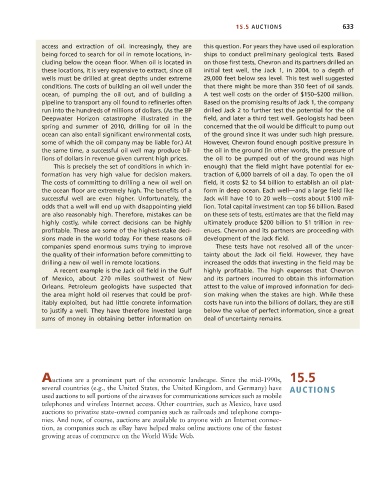Page 659 - Microeconomics, Fourth Edition
P. 659
c15riskandinformation.qxd 8/16/10 11:10 AM Page 633
15.5 AUCTIONS 633
access and extraction of oil. Increasingly, they are this question. For years they have used oil exploration
being forced to search for oil in remote locations, in- ships to conduct preliminary geological tests. Based
cluding below the ocean floor. When oil is located in on those first tests, Chevron and its partners drilled an
these locations, it is very expensive to extract, since oil initial test well, the Jack 1, in 2004, to a depth of
wells must be drilled at great depths under extreme 29,000 feet below sea level. This test well suggested
conditions. The costs of building an oil well under the that there might be more than 350 feet of oil sands.
ocean, of pumping the oil out, and of building a A test well costs on the order of $150–$200 million.
pipeline to transport any oil found to refineries often Based on the promising results of Jack 1, the company
run into the hundreds of millions of dollars. (As the BP drilled Jack 2 to further test the potential for the oil
Deepwater Horizon catastrophe illustrated in the field, and later a third test well. Geologists had been
spring and summer of 2010, drilling for oil in the concerned that the oil would be difficult to pump out
ocean can also entail significant environmental costs, of the ground since it was under such high pressure.
some of which the oil company may be liable for.) At However, Chevron found enough positive pressure in
the same time, a successful oil well may produce bil- the oil in the ground (in other words, the pressure of
lions of dollars in revenue given current high prices. the oil to be pumped out of the ground was high
This is precisely the set of conditions in which in- enough) that the field might have potential for ex-
formation has very high value for decision makers. traction of 6,000 barrels of oil a day. To open the oil
The costs of committing to drilling a new oil well on field, it costs $2 to $4 billion to establish an oil plat-
the ocean floor are extremely high. The benefits of a form in deep ocean. Each well—and a large field like
successful well are even higher. Unfortunately, the Jack will have 10 to 20 wells—costs about $100 mil-
odds that a well will end up with disappointing yield lion. Total capital investment can top $6 billion. Based
are also reasonably high. Therefore, mistakes can be on these sets of tests, estimates are that the field may
highly costly, while correct decisions can be highly ultimately produce $200 billion to $1 trillion in rev-
profitable. These are some of the highest-stake deci- enues. Chevron and its partners are proceeding with
sions made in the world today. For these reasons oil development of the Jack field.
companies spend enormous sums trying to improve These tests have not resolved all of the uncer-
the quality of their information before committing to tainty about the Jack oil field. However, they have
drilling a new oil well in remote locations. increased the odds that investing in the field may be
A recent example is the Jack oil field in the Gulf highly profitable. The high expenses that Chevron
of Mexico, about 270 miles southwest of New and its partners incurred to obtain this information
Orleans. Petroleum geologists have suspected that attest to the value of improved information for deci-
the area might hold oil reserves that could be prof- sion making when the stakes are high. While these
itably exploited, but had little concrete information costs have run into the billions of dollars, they are still
to justify a well. They have therefore invested large below the value of perfect information, since a great
sums of money in obtaining better information on deal of uncertainty remains.
Auctions are a prominent part of the economic landscape. Since the mid-1990s, 15.5
several countries (e.g., the United States, the United Kingdom, and Germany) have AUCTIONS
used auctions to sell portions of the airwaves for communications services such as mobile
telephones and wireless Internet access. Other countries, such as Mexico, have used
auctions to privatize state-owned companies such as railroads and telephone compa-
nies. And now, of course, auctions are available to anyone with an Internet connec-
tion, as companies such as eBay have helped make online auctions one of the fastest
growing areas of commerce on the World Wide Web.

